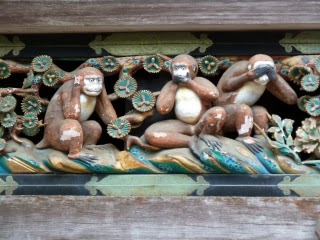The quiet mountain town of Nikko is a popular day trip from Tokyo. Its a spiritual place filled with sacred temples and shires. Most of its sights are nestled on a heavily wooded hillside rising from the edge of town. It’s also the site of a mausoleum for Tokugawa Ieyasu, the warlord who united Japan under a shogunate regime that lasted until the current imperial order was restored in 1867.
The areas two most famous venues are Tosho-gu shrine and Rinno-ji temple. Visitors coming from town must cross the Diaya River. Today this involves nothing more than a road bridge. However, in ancient times, most visitors had to ford the river. The Shogun however could cross using Shin-kyo an elegant red wooden arch bridge. The bridge still stands. It was recently restored and is now open to anyone keen to pay an entrance fee.
Unfortunately Rinno-ji temple is currently undergoing restoration. The entire structure is wrapped in scaffolding and enclosed by an enormous temporary shed. This left us with plenty of time to explore the neighbouring Tosho-go shrine. The main entrance to the complex is marked by a five-story pagoda that dates back to 1650. However, the current structure was built in 1818.
Remarkably the building’s stability is maintained during earthquakes by special dampening structure. A long timber pillar is suspended internally from its upper floors. The inertia of swaying weight absorbs the worst of a earthquake's movement thus saving the building from collapse.
Perhaps the shrine’s most famous sights are the Yomei-mon, an intricately decorated gate. Its surface is adorned by elaborate carvings, many of them gilded or covered in red lacquer. The details are extraordinary. The overall design feels surprisingly Chinese, unlike the recently restored, and equally beautiful hall that sits behind it. Restoration work continues on another equally elaborate gate nearby.
The same internal courtyard included Honji-do, a hall with a huge dragon painted on its ceiling. However, the hall’s most astonishing quality is not the artwork, but rather its unusual acoustics. A resident monk happily demonstrates its reverberation by clapping two wooden blocks. The lingering echoes really are breath-taking.
However, the least satisfying sight was Ieyasu’s tomb. To reach it we climbed what seemed like hundreds of stairs winding their way through the hillside’s towering cedars. The tomb proved to be a rather unimpressive, simple affair. We’d been given a map that had referred to it as the ‘sleeping cat’. However, there was nothing on the site that vaguely resembled anything remotely feline. I later learnt that the sleeping cat was in fact a small statue we’d missed at the base of the first stairway.
The areas two most famous venues are Tosho-gu shrine and Rinno-ji temple. Visitors coming from town must cross the Diaya River. Today this involves nothing more than a road bridge. However, in ancient times, most visitors had to ford the river. The Shogun however could cross using Shin-kyo an elegant red wooden arch bridge. The bridge still stands. It was recently restored and is now open to anyone keen to pay an entrance fee.
Unfortunately Rinno-ji temple is currently undergoing restoration. The entire structure is wrapped in scaffolding and enclosed by an enormous temporary shed. This left us with plenty of time to explore the neighbouring Tosho-go shrine. The main entrance to the complex is marked by a five-story pagoda that dates back to 1650. However, the current structure was built in 1818.
Remarkably the building’s stability is maintained during earthquakes by special dampening structure. A long timber pillar is suspended internally from its upper floors. The inertia of swaying weight absorbs the worst of a earthquake's movement thus saving the building from collapse.
A stairway draws visitors up the hill and through the main gate, which is protected on either side by Deva Kings. I’ve seen a number of these guardians over the years. Nikko’s pair are among the most impressive. Inside the grounds visitors are greeted by a number of famous buildings including the Shinkyusha, or sacred stable. The eaves of the building include a relief carving of the famous “hear no evil, see no evil, speak no evil” trio of monkeys.
Perhaps the shrine’s most famous sights are the Yomei-mon, an intricately decorated gate. Its surface is adorned by elaborate carvings, many of them gilded or covered in red lacquer. The details are extraordinary. The overall design feels surprisingly Chinese, unlike the recently restored, and equally beautiful hall that sits behind it. Restoration work continues on another equally elaborate gate nearby.
The same internal courtyard included Honji-do, a hall with a huge dragon painted on its ceiling. However, the hall’s most astonishing quality is not the artwork, but rather its unusual acoustics. A resident monk happily demonstrates its reverberation by clapping two wooden blocks. The lingering echoes really are breath-taking.
However, the least satisfying sight was Ieyasu’s tomb. To reach it we climbed what seemed like hundreds of stairs winding their way through the hillside’s towering cedars. The tomb proved to be a rather unimpressive, simple affair. We’d been given a map that had referred to it as the ‘sleeping cat’. However, there was nothing on the site that vaguely resembled anything remotely feline. I later learnt that the sleeping cat was in fact a small statue we’d missed at the base of the first stairway.


















No comments:
Post a Comment